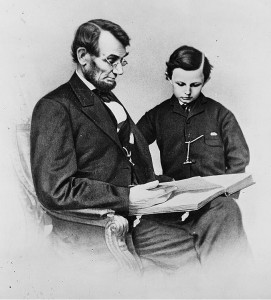By Matthew Pinsker
We are looking for a few good close readings at the Lincoln’s Writings website and through the Understanding Lincoln online graduate course, but what makes for a successful close reading of a Lincoln document? The term can mean different things in different disciplines. But for historians, there are typically three essential components for analyzing written primary sources:
- Text
- Context
- Subtext
 A good close reading of a Lincoln document will open by drawing the reader right into the heart of Lincoln’s own text, usually with a snippet of quotation. Lincoln is arguably America’s greatest writer, certainly its greatest political writer, and so it makes sense to engage his words up front. But a close reading should never simply turn into a litany of quotations. Close readers must strive to summarize their subject’s words in a fair and compelling manner, sometimes with keywords, or short quotations, but always through a determined, organized and thoughtful effort to explain meaning with insightful paraphrase. All of the close readings published at this multi-media edition aspire first and foremost to convey what Lincoln wrote in a manner that modern students can understand.
A good close reading of a Lincoln document will open by drawing the reader right into the heart of Lincoln’s own text, usually with a snippet of quotation. Lincoln is arguably America’s greatest writer, certainly its greatest political writer, and so it makes sense to engage his words up front. But a close reading should never simply turn into a litany of quotations. Close readers must strive to summarize their subject’s words in a fair and compelling manner, sometimes with keywords, or short quotations, but always through a determined, organized and thoughtful effort to explain meaning with insightful paraphrase. All of the close readings published at this multi-media edition aspire first and foremost to convey what Lincoln wrote in a manner that modern students can understand.
Historians, however, just refuse to believe that anyone can truly understand text without context, and so any good close reading of a Lincoln document should also provide readers with relevant historical context. Yet relevance is such a slippery and often elusive concept. There is no strict formula for deciding what’s relevant or not, but all good close readings of Lincoln’s writings will attempt to enhance their summary of his text with coherent (and compact) information that helps readers more fully appreciate his intentions and, even more important, to situate the document’s significance within a broader historical narrative. Close readings must answer those perennial questions: who, what, when, where and why. Yet along the way, they must also overcome the age-old “so what” threshold. They must address significance. Thus, good historical context requires research outside the text itself, perhaps not as extensive as for an article or research paper, but extensive nonetheless. You should never attempt a careful close reading of a Lincoln document without examining (and citing) a variety of primary and secondary sources.
Ultimately, the purpose of all of this effort is to achieve a greater appreciation for subtext or hidden purpose. The serious Lincoln historian reads Lincoln’s writings closely in order to understand the strategy behind his word choices, to appreciate the mastery that often underlay his craft, but also (at least sometimes) to expose any mistakes or shortcomings in his approach. Such analysis is inherently creative and subjective, prone to vigorous debate. But the very best close readings will deliver a powerful new perspective on some element of Lincoln’s thought and career. In other words, they will achieve the astonishing –to contribute something new about the most analyzed figure in American history.
If all this sounds daunting, it should not. Like every other type of historical analysis, no close reading is ever perfect or even final. Certainly, nothing at this site pretends to be so. But here are some of the very best examples of strong close readings undertaken in recent years by Dickinson College undergraduates or by Gilder Lehrman graduate students and published at this site:
- Mary Beth Donnelly, First Letter to Eliza Gurney (Understanding Lincoln, Summer 2013)
- Jesse O’Neill, A Fair Match for Falstaff (Understanding Lincoln, Summer 2014)
- Susan Segal, A Letter to George McClellan (Understanding Lincoln, Summer 2013)
- Moyra Schauffler, Lincoln Responds to Seward (Dickinson College, Spring 2015)
- Megan VanGorder, Letter to Fanny McCullough (Understanding Lincoln, Summer 2013)
These choices, however, represent only five out of the more than one hundred close readings now published at this site and available for free educational use. Perhaps yours will one day be part of this growing list as well.
